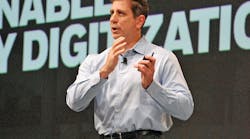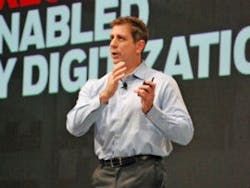“An interesting thing about the distributed control system is it hasn’t been distributed. Now, the C300 will be able to communicate with any I/O on the IO HIVE network, to discover and bond with it.” Honeywell’s Jason Urso explained the efficiency and savings of HIVE technology at the opening session of Honeywell Users Group Americas 2019 in Dallas.
The world is changing at an unprecedented pace. “We see more mobile workers, making faster and more precise decisions,” said Jason Urso, chief technology officer, Honeywell Process Solutions. “Facilities are more productive and safer than ever, but we can still do better.”
Urso spoke to attendees of his Technology Overview keynote session at Honeywell Users Group Americas 2019 this week in Dallas.
“Honeywell is focused on project speed and efficiency, superior operations and infinite system longevity,” Urso said. “We’re moving to a new foundation and capabilities for a new generation.”
Harness the HIVE
“A few years ago, we built on the Experion Process Knowledge System (PKS) with LEAP—Lean Execution for Automation Projects—consisting of Universal IO that can be configured in the field, moving from mass customization to mass standardization of hardware, and virtualization to separate hardware from software,” Urso said. “Now, we’re changing the way we think about and implement systems with PKS Highly Integrated Virtual Environment (HIVE).”
PKS HIVE uses LEAP project execution principles, software and networking to unchain control applications from physical equipment, and controllers from physical I/O. This enables control systems to be engineered and implemented in less time, at lower cost and risk and with simpler, modular builds. The solution also transforms the way control systems are maintained over their lifecycles, shifting day-to-day management of servers to a centralized data center, where experts and established protocols mitigate cybersecurity risk, allowing plant engineers to focus more proactively on optimization of their control systems.
Experion PKS HIVE incorporates three elements—IT HIVE, IO HIVE and Control HIVE—that can be used individually or collectively, in tandem with customers’ existing systems and infrastructures:
-
Experion PKS IT HIVE centralizes up to 80% of the IT infrastructure traditionally used in project engineering to lower project delivery and lifecycle costs, better leverage skills and drive consistent physical and cybersecurity management across an enterprise.
-
Experion PKS IO HIVE provides flexible I/O and control distribution, enabling the control system to become a natural extension of process equipment and to facilitate modular and parallel project execution.
-
Experion PKS Control HIVE uniquely applies control containers to provide flexibility and standardization of control hardware platform, control location and control engineering. With multiple physical controllers operating as part of an Experion PKS Control HIVE, control engineering is dramatically simplified through automated load balancing.
Distributing the DCS
“An interesting thing about the distributed control system is it hasn’t been distributed,” Urso said. The new Experion PKS IO HIVE network is a fault-tolerant, high-speed field network that allows the C300 [controller] to communicate with distributed I/O. “Now, the C300 will be able to communicate with any I/O on the IO HIVE network to discover and bond with it.”
Cybersecurity is provided with a firewall adjacent to each field I/O module and optional network encryption. Shifting I/O to the field eliminates the I/O cabinets in the control center, and using fiberoptic cable eliminates 4-20 mA wiring back to the control center.
Further, Universal IO will be able to do local control, extending control into the field in local cabinets with 20 ms cycle times. “The I/O can be programmed with a subset of C300 functionality—it’s a virtual C300—providing full peer-to-peer control in the field and back to C300 in the control center,” Urso said. Control can be entirely in remote process cabinets in the production areas. The apportioning of control is flexible—either in the field, in the control center or a hybrid of the two.
The remote process cabinets support universal wireless hotspots that can connect for control and provide wireless access for field operators with mobile devices. “For example, if a technician is performing a procedure for a process penetration, they can know if the pipe is properly prepared,” Urso said. “They can access the system and interlocks to ensure the purge is done and it’s safe to perform the procedure.”
With IO HIVE and SmartLine wireless transmitters with prebuilt templates and wireless configuration, instruments can be commissioned independent of the control system. “Using C300 on a laptop—Experion on a laptop—technicians can commission devices as if they were connected to the system, in the module yard.”
Control HIVE also allows multiple controllers to present as a single controller. “With the rigid, hierarchical model defined by hardware, we used to assemble, wire and assign control strategies to controllers,” Urso said. “Then, to make late changes, we’d add I/O, reconfigure the controller, maybe add controllers and redistribute assignments to rebalance loads. It’s a very circular activity.
“Control HIVE revolutionizes control engineering. We assign controls to the HIVE, which integrates and distributes them automatically. Any controller can communicate with any I/O. This eliminates hundreds of steps when adding I/O and/or control strategies. If you need more capacity, just add controllers. Late changes become completely flexible.”
Using a new virtual controller and separating hardware from software, “we can now run control on virtually any PC or server,” Urso said. “It can run in the field or in a data center and be deployed anywhere.” The virtual-controller technology will be part of the Experion release in December.
Corralling IT
IT HIVE reduces the cost of IT infrastructure at process facilities, which can now focus on process control, not IT. “We’ve already consolidated hardware requirements 80% by virtualization, but you still need on-site servers and IT expertise. Now, we centralize IT management using a high-speed network and a fault-tolerant infrastructure, with minimal hardware on-site and virtual systems stored off-site that are deployed on-site as needed,” Urso said. “During normal operations, most control is run virtually, off-site, with only the essential applications on-site. If off-site communication is lost, the plant continues to run on the virtualized and replicated images that remain on-site.”
For multi-site consolidation and enterprise standardization, users can have a single Experion release, hot fixes and patches and continually swap in updated systems. They can consolidate multiple Experions and retain full local fault tolerance. And even the most remote locations get a full IT infrastructure.
“We use it for Honeywell control-as-a-service,” Urso said. “It’s being done now for terminal automation, where we have enterprise, as well as local views, simultaneously.”
The Experion PKS IT HIVE and IO HIVE can be ordered now, with deliveries beginning in the first quarter of 2020. Experion PKS Control HIVE will be available in the second half of 2020. For more information, watch the Experion PKS HIVE video.
ELCN and beyond
Seamless evolution from TDC 3000 to Experion is a simple three-step procedure that can be done on-process, and users may be further along than they realize. The first step is to move to Experion Station TPS, preserving your intellectual property (IP) with your choice of old, new or both operator interface views.
The second step is to move from HPM to EHPM, running on fault-tolerant Ethernet while preserving displays and IP.
The third step is ELCN, which virtualizes legacy physical hardware. “In December, we’re adding a network gateway, so any TDC network of any complexity can move to ELCN,” Urso said. “You can remove all the physical control hardware and put control on any modern hardware. There’s no component obsolescence; it’s all in software.”
PM IO migrated to Series C IO 10 years ago. “Since then, PM IO cards have been coming with Series C hardware,” Urso said. “You’ve been replacing PM with ELCN that has PM functionality.” At the same time, HPM has become C300. “EHPM is an HPM plus C300. We’ve been turning on the functionality over time. With a simple three-step operation, TDC 3000 has seamlessly melted into Experion, completely on-process—a new system.”
Urso closed the session with glimpses at Unified Engineering Tools that will allow TDC control engineering methods to meld into Control Builder Graphical CL Editor, to be released in December, and for mid-2020, TDC PM IO HART modules that will share data with FDM via EHPM.





